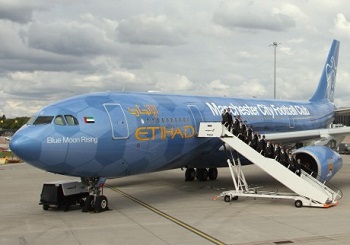Football Club & Airline Sponsorship – The Sky’s The Limit
By Matt Davis | 24th September 2019
It was a summer full of records. Manchester United broke the British record for the most expensive footballer when Angel Di Maria left Real Madrid for a staggering £63 million fee. Earlier in the summer, the Red Devils broke the record again when they signed Adidas as their new kit manufacturer starting from 2015-16 for a world record £75 million per season. And another record which went under the radar during the end of the last campaign was the total income for Premier League clubs through shirt sponsorship reaching a high of £191 million for the forthcoming season.
According to Deloitte’s 2014 findings of the 10 biggest clubs commercially in world football, 6 of those were sponsored specifically by airlines, with those big clubs including: Real Madrid, Arsenal, Barcelona, Manchester City, AC Milan and Paris Saint-Germain, of which 4 are sponsored by Fly Emirates. Meanwhile, Manchester City are getting their funding from Etihad Airways and Barcelona gain their money from Qatar Airways having had a previous relationship with the Qatar Foundation. As well as this, if reports are true, Chelsea could be set to be the 7th of the ‘big 10 clubs’ to follow suit, with Turkish Airlines being set up to takeover from Samsung when the current deal ends in May.
The exposure which is granted within football sponsorship is vast, and with a relatively untapped market of potential football fans across America, Africa and Asia, there is huge commercial avenues for companies to explore, especially for the likes of international airlines to promote their product with the potential of huge returns. This is echoed further by Etihad airways not only sponsoring the current Premier League Champions, but also sponsoring Melbourne City Football Club and the MLS, leading the way for huge exposure which could maximise their brand awareness in three different continents.
But how did football sponsorship blossom in such a way that the likes of Qatar Airways, a nation who is not known for having passionate football fans, sign to become Barcelona’s first corporate sponsor back in 2011.
According to Dan Jones from Deloitte, airlines and other big companies see football as the ideal way for sponsorship due to its transnational state. Jones states, “As European economies struggle with recessionary pressures, which may make securing sponsorship and investment challenging domestically, there is an appetite from both European clubs and Middle Eastern companies alike to forge new partnerships.” This partnership is further illuminated by Manchester City who are set to enter a £40 million a year deal with Etihad Airways who will continue to sponsor the City of Manchester Stadium for the next ten years, with Manuel Pellegrini’s men expected to raise even more funds to fight against Financial Fair Play by finding a sponsor for their new state-of-the-art training centre which just opened, potentially doubling their current sponsorship figure.
It is argued that Fly Emirates, having bought Paris-Saint Germain most recently, are trying to build Dubai up as a centre for sports branding, with potential returns in the future proving to make this heavy spend a worthwhile investment, and why would it not be? With Qatar winning the World Cup and Fly Emirates expanding their sponsorship portfolio, combining with Manchester City owner, Sheikh Mansour also creating clubs in Australia’s A-League and creating a franchise in New York for the MLS, the global exposure which can be expected makes this huge outlay of cash to not be as financially naïve which we might have thought it could be.
In a realistic sense, shirt sponsors bare no relation to the fans. Whilst the shirt might resemble an identity for many to associate with, the logo underneath rarely even appeals to the domestic audience. Let’s take QPR for example; a club sponsored by AirAsia, a company who don’t even fly within Europe. Commercialisation in the Premier League, as well as being the most watched domestic football league in the world comes with this baggage of unfamiliarity which is set to be scrutinised even further with suggestions that Premier League games could be played abroad.
Where can we expect football sponsorship to head in the future? Well with countries such as Azerbaijan sponsoring Atletico Madrid, and the Qatar Tourist Board backing PSG in a four year deal estimated to cost around $200 million, there is no doubt that other similar countries could follow this pattern and match investments such as this.
Written by Matt Davis

